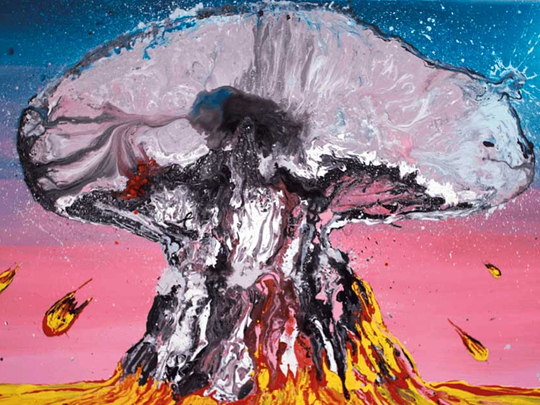
Italian artists Michela Zasio, Cristiano Carotti and Luca Valentini are appealing to mankind to stop destroying our planet in their joint show, Dead Cities. Each artist has highlighted in his own way how the greed, aggression and callousness of human beings has led to the destruction of historic cities, the loss of numerous lives and a disturbance in the balance of nature which has long term implications for our environment and all living creatures on Earth. Their paintings of ruined cities, nuclear explosions, dead trees and depressing ambiences speak about cities that are bereft of any sign of life, which could possibly take root and help to rebuild civilisation. But while contemplating our disastrous mistakes of the past and the present, the artists also hold out hope for a revival of the world and its crushed ideals in the future.
Zasio’s paintings of dead trees, and ancient ruins reminisce about a bygone era when human beings lived in harmony with nature and raise questions about how and when that balance changed so drastically. The artist had travelled to Syria eight years ago and his paintings are based on his vivid memories of the beautiful landscape, architecture and people of the country. “I was struck by the contrast between the raw burnt umber and sepia, arid and dry soil, withered trees and dusty plants; the black, pink and green of the buildings and the mountain slopes around Damascus; and the elegance of the men, the colourful clothes of the women and the light in their eyes behind the veil. I remember the many colours of the lush vegetation in the Orontes valley, the almost lunar atmosphere of the rocky mountains surrounding the ruins of Serjilla, a Byzantine settlement where flocks of sheep grazed, and the reddish landscape surrounding Aleppo. It was also amazing to see the contrast between the impressive ruins of Palmyra and the modern town of Tadmor nearby. These sights and the emotions associated with them are etched in my mind. All those memories came flooding back when I watched the news about the protests in Homs, and the continuing violence in Syria,” Zasio says.
The artist’s large scale paintings depict the ancient structures in Palmyra which have survived for millennia but whose fate is unknown now. The beautiful ruins look like vestiges of a violated civilisation, an ethereal memory of a past that the violence of men cannot erase. In contrast Carotti’s paintings of fiery mushroom clouds spreading across a barren landscape, comment on the destructive power of human beings, their mindless use of this power, and the possibility of a nuclear disaster in the future.
Valentini looks at the present and the future with a more positive attitude. His portraits of well-known celebrities and pop figures present his own witty version of famous magazine covers, reminding us of the goodness and purity that is part of human nature, and that we admire in these icons. Alongside these portraits, he is also displaying portraits of mysterious, ambiguous, masked figures, perhaps the heroes of the future who will help civilisation to survive our self-created disasters.
Dead Cities will run at Sconci Art Gallery in Dubai Design District until April 30.












